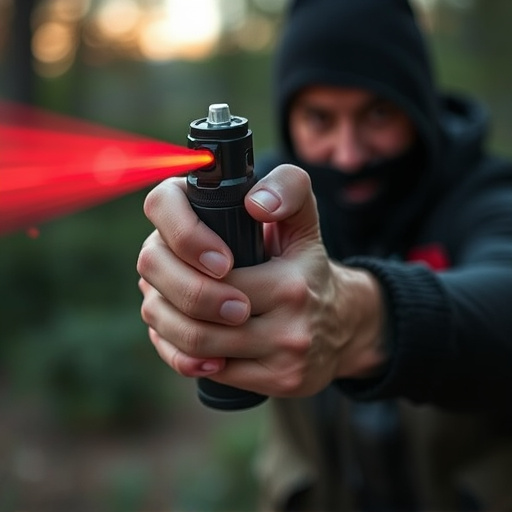Treating Pepper Spray Chemical Burns: A Quick Guide
Immediate action is crucial when treating pepper spray burns. Rinse the affected area with water for 15-20 minutes to dilute capsaicin, then apply cold compresses and over-the-counter anti-inflammatory drugs for mild symptoms. For severe reactions or prolonged discomfort, seek medical attention. Prevent infection by avoiding scratching and applying mild creams or aloe vera gel. Always flush pepper spray contact with water first, even if seeking medical help, to minimize potential long-term damage from this powerful irritant.
Personal security is a crucial aspect of modern life, especially with the increasing prevalence of unpredictable situations. One such tool, pepper spray, offers a powerful defense mechanism but can also lead to painful chemical burns. This article delves into understanding the causes and effects of these burns, providing essential knowledge on Treating Pepper Spray Chemical Burns. We explore topical care, home remedies, and the significant role personal security products play in self-defense strategies.
- Understanding Pepper Spray Chemical Burns: Causes and Effects
- Treating the Inflammation: Topical Care and Home Remedies
- The Role of Personal Security Products in Self-Defense
Understanding Pepper Spray Chemical Burns: Causes and Effects
Pepper spray, a common self-defense product, utilizes capsaicin, the active ingredient found in chili peppers, to cause temporary disorientation and immobilization. When pepper spray comes into contact with skin or eyes, it triggers a chain reaction of events leading to chemical burns. The burning sensation is due to the activation of pain receptors, causing an intense inflammatory response. This can result in redness, swelling, and severe irritation.
Treating Pepper Spray Chemical Burns involves immediate and thorough washing with water to dilute the pepper spray residue. Soaps or cleansers can aid in removing any remaining irritants. For eye exposure, flushing with clean water for at least 15 minutes is crucial to prevent lasting damage. Medical attention may be necessary for severe reactions, including difficulty breathing, nausea, or prolonged pain and discomfort. Applying cold compresses and using over-the-counter anti-inflammatory medications can help alleviate symptoms and promote healing in mild cases.
Treating the Inflammation: Topical Care and Home Remedies
Treating pepper spray chemical burns requires immediate and proper care to alleviate discomfort and promote healing. The first step is to rinse the affected area thoroughly with copious amounts of water for at least 15-20 minutes. This washes away the irritant and helps to reduce its potency. After rinsing, using mild, over-the-counter (OTC) creams or ointments can soothe inflammation and prevent infection. Aloe vera gel is particularly effective due to its cooling properties and natural anti-inflammatory agents.
Home remedies like applying a cold compress or soaking the injured area in cool water can also help alleviate pain and swelling. Using a clean cloth soaked in cool water, gently press against the skin for about 10 minutes at a time can provide relief. Additionally, some people find relief by using essential oils like tea tree oil or lavender oil, which have anti-inflammatory and antimicrobial properties. However, it’s crucial to avoid scratching or rubbing the affected area, as this can exacerbate irritation and potential damage.
The Role of Personal Security Products in Self-Defense
Personal security products, like pepper spray, play a significant role in self-defense by providing individuals with an effective and readily available tool to deter and defend against potential threats. In today’s world, where personal safety is a top concern, these products offer a simple yet powerful solution for anyone facing a dangerous situation. Pepper spray, in particular, has become a popular choice due to its non-lethal nature and ability to disable an attacker temporarily, giving the user precious time to escape or seek help.
When it comes to defending against violent attacks, knowing how to treat pepper spray chemical burns is crucial. These burns can occur if the spray makes contact with skin or eyes, causing immediate discomfort and potential long-term damage if left untreated. Therefore, understanding first aid measures for such injuries is essential. Treating Pepper Spray Chemical Burns involves flushing the affected area thoroughly with water and seeking medical attention to prevent any adverse reactions or complications.
In understanding the potential risks and effects of pepper spray exposure, it’s evident that proper treatment is key to managing inflammation. By utilizing topical care and exploring home remedies, individuals can effectively alleviate discomfort and speed up recovery from chemical burns caused by pepper spray. Moreover, personal security products designed for self-defense play a crucial role in empowering individuals to protect themselves, offering a powerful tool for navigating potentially dangerous situations. When it comes to treating pepper spray chemical burns, knowledge of both medical interventions and preventive measures is essential for ensuring safety and well-being.
